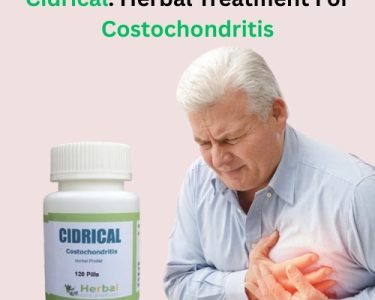Costochondritis, a condition characterized by inflammation of the cartilage connecting the ribs to the breastbone, can cause significant chest pain. While often benign, the pain can mimic heart issues, leading to concern and discomfort. Fortunately, various medications for costochondritis can help manage symptoms effectively. The top five expert-recommended options to alleviate pain and inflammation.
What is Costochondritis?
Costochondritis is an inflammatory condition that affects the cartilage connecting your ribs to your breastbone (sternum). This area, known as the costosternal joint or costochondral junction, plays a key role in the flexibility and movement of your chest.
Symptoms of Costochondritis
The primary symptom of costochondritis is chest pain, which can:
- Be sharp, aching, or pressure-like.
- Be localized to one side of the chest, usually near the middle or upper ribs.
- Worsen with physical activities, deep breathing, coughing, or pressing on the affected area.
- Sometimes mimic heart attack pain, leading to unnecessary concern.
Causes of Costochondritis
The exact cause of costochondritis is often unclear, but possible contributors include:
- Physical Strain: Overuse from heavy lifting, intense exercise, or repetitive movements.
- Injury: Trauma to the chest area, such as a fall or car accident.
- Infections: Rare bacterial or viral infections affecting the joints.
- Arthritis: Conditions like osteoarthritis or rheumatoid arthritis can sometimes extend to the rib joints.
- Stress on the Chest Wall: Prolonged coughing or respiratory infections can irritate the cartilage.
Top 5 Medications for Costochondritis
Costochondritis is an inflammation of the cartilage that connects the ribs to the breastbone, often leading to chest pain that can mimic a heart attack. Treatment typically involves medications to manage pain and inflammation. Here are the top 5 medications commonly used to treat costochondritis:
1. Nonsteroidal Anti-Inflammatory Drugs (NSAIDs)
NSAIDs are the first line of defense for managing costochondritis symptoms. These medications help reduce inflammation and relieve pain. Commonly used NSAIDs include:
- Ibuprofen (Advil, Motrin)
- Naproxen (Aleve)
Dosage: Follow your doctor’s recommendations, as overuse can cause stomach irritation or kidney issues.
Benefits: Effective for short-term pain relief and reducing inflammation.
2. Acetaminophen
If NSAIDs are unsuitable due to contraindications (e.g., stomach ulcers or kidney disease), acetaminophen (Tylenol) is a safer alternative. While it doesn’t target inflammation, it effectively alleviates pain.
Dosage: Standard adult doses are 500-1000 mg every 4-6 hours, not exceeding 4000 mg daily.
Benefits: Gentle on the stomach, making it ideal for individuals with gastrointestinal sensitivity.
3. Topical Analgesics
Topical creams, gels, or patches containing pain-relieving ingredients can provide localized relief. Popular options include:
- Diclofenac gel (Voltaren)
- Capsaicin cream
How They Work: These products are applied directly to the chest area to numb the pain and reduce inflammation without systemic side effects.
Benefits: Minimizes risk of gastrointestinal or systemic side effects common with oral medications.
4. Muscle Relaxants
For patients whose costochondritis involves muscle tension or spasms, muscle relaxants like cyclobenzaprine (Flexeril) can be beneficial.
How They Help: By reducing muscle tension, they complement anti-inflammatory treatments for comprehensive symptom relief.
Caution: Muscle relaxants can cause drowsiness; avoid driving or operating heavy machinery after use.
5. Corticosteroid Injections
For severe or persistent costochondritis, corticosteroid injections directly into the affected area may be recommended. These injections provide powerful, targeted anti-inflammatory action.
Procedure: Administered by a healthcare provider under sterile conditions.
Benefits: Offers rapid and prolonged relief for individuals unresponsive to oral medications.
Note: This option is typically reserved for cases where other treatments have failed.
Additional Tips for Managing Costochondritis
While medications are essential, combining them with lifestyle adjustments can enhance recovery:
- Rest: Avoid activities that worsen the pain, such as heavy lifting or strenuous exercise.
- Heat/Cold Therapy: Alternating heat and cold packs can help reduce inflammation and relax muscles.
- Stretching Exercises: Gentle stretching can improve chest wall mobility and reduce stiffness.
When to See a Doctor
If your symptoms persist despite treatment or worsen over time, consult a healthcare professional. While costochondritis is generally non-serious, other conditions (e.g., heart issues) can mimic its symptoms. A proper diagnosis ensures appropriate treatment.
Conclusion
Costochondritis can be painful, but effective medications for costochondritis, such as NSAIDs, acetaminophen, topical analgesics, muscle relaxants, and corticosteroid injections, provide relief. Always consult a healthcare provider before starting any new medication to ensure it is safe and suitable for your specific needs. With the right approach, you can manage symptoms and improve your quality of life.




